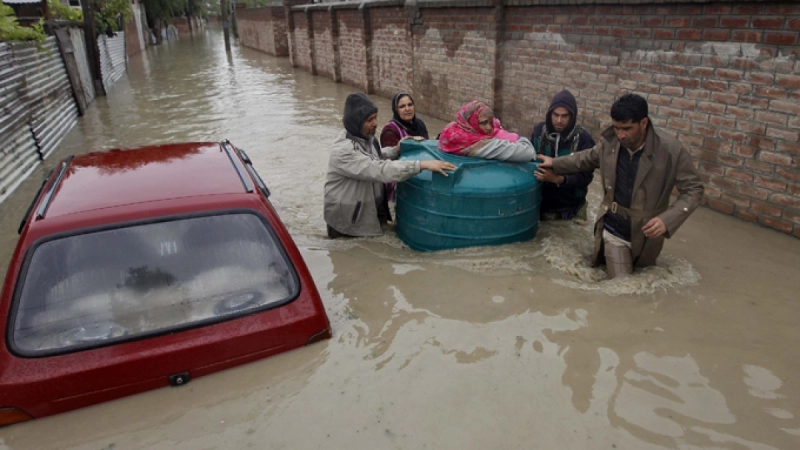As if the ongoing political crisis was not enough, we are in the middle of a natural disaster, once again. As before, the state appears to be woefully unprepared. More than 23 districts in Punjab, 10 in Azad Jammu and Kashmir and five in Gilgit-Baltistan have been affected by the September rains killing more than 270 and affecting 2.4 million people. The federal government says that nearly 45,000 houses have been damaged and 1,544,653 acres of irrigated lands have been inundated thereby impacting livelihoods.
Taken by surprise, the federal and provincial governments are running around undertaking rescue work with plenty of photo-op sessions. The Pakistan Army remains the most resourceful arm of the government and has rescued thousands of stranded people. Once again, the detractors of democratic governance many of whom are assembled on the streets of Islamabad view this calamity as another sign of failed fake democracy.
If media reports are true then the current government, despite briefings, did not accord disaster risk reduction the priority it needed. If anything, the disturbing scenes of a submerged Lahore made a mockery of the Metro Bus glory that was achieved only a year ago. Without a local government, proper drainage and early warning systems, Lahore’s development meant nothing for all those who suffered in the rains.
Time and again, it has been proved that the state’s efficacy at the local level is seriously hampered by the dilution of the district management cadres more than a decade ago and the refusal of political parties to install elected local governments. This is why the chief minister of Punjab and the prime minister are touring all the areas and fulfilling the functions of otherwise accountable and empowered local authorities.
Granted that the scale of rains was abnormal and the neighbouring Indian-administered Jammu and Kashmir suffered like our Punjab province. But we have been dealing with natural disasters since 2010.
After the deadly floods of 2010, I was part of a team that drafted the Disaster Needs Assessment report. The comprehensive document was prepared for the government of Pakistan and it both assessed and recommended actions to avoid and better manage the disasters. A few lessons highlighted in the document included the way the disaster overwhelmed national, provincial and local disaster/flood management capacities, particularly at the district level. In addition, the report also mentioned how the national response and contingency plans were not fully implemented and that Pakistan’s early warning systems were flawed especially at the community levels; and disaster preparedness awareness for populace situated within flood plains had to be augmented.
There were subsequent floods in the following years and the national and provincial disaster management authorities were strengthened with varying resources. The recent floods arrived when the priority of a besieged federal government was to survive in office. This is what political instability does. Policy focus and the concerted ability of the state agencies perilously dwindle.
The two key institutions, the National Disaster Management Authority (NDMA) and the federal flood commission, are evidently underperforming. The reasons are familiar: inadequate funding and moribund management structures compounded by the fact that technical experts are subservient to the generalists. The Punjab wing of the disaster management authority could not respond in the manner it was expected. There is a Monsoon Contingency Plan but without local institutions, the implementation of any contingency plan would be difficult. The district level authorities are yet to be fully operational. It has been reported that the meteorological department had warned of extraordinary rains. But it was not important enough for the federal and provincial governments and the mammoth bureaucracies they lord over.
The long-term climate change data has been showing scenarios of future occurrence of heavy rainfall during monsoon seasons. Recently, the UN-led Intergovernmental Panel on Climate Change launched its 5th Assessment Report in Islamabad. Data from Pakistan shows increase in temperature and sea level rise, variations in rainfall, among other trends. Experts have been highlighting that in Pakistan climate change-related impacts are largely linked to governance. Pakistan’™s vulnerability to climate shifts stems from the disaster risks and endemic poverty. Policy interventions therefore have to focus on governing adaptation to climate change and supporting vulnerable communities towards better preparedness.
Our response to climate change has been more chaotic than the natural phenomena. Devolution reform of 2010 abolished the environmental ministry and then a ministry of national disaster management was created. Soon, a ministry for climate change was carved out only to be turned into a division last year. In four years, this has been the fourth institutional shake-up making a joke of how the country intends to steer and implement the climate-change agenda. Global covenants sadly don’t mean much to governments obsessed with short-term populist gains.
The total budget of the climate change division for the current year is a measly Rs25 million which reflects our priorities. The civilians want more Metros and highways while the khakis want newer tanks and missiles. Add to this the engineered political instability and there is a fit case for a country determined to consume itself. Not being able to store and manage water, we lay all the blame on outsiders and even this time, the Indian conspiracy to deluge Pakistan has resurfaced its convenient head.
What is happening next door in Jammu and Kashmir is no different. The NDMA across the border has turned out to be as ineffective as the one in Pakistan. Both prime ministers have exchanged letters with good intentions but their words need to translate into common flood management plans and more significantly, joint regional agendas on climate change. No country on its own can prepare for the changes underway.
It would be essential that the federal and provincial governments unlock the various reports of the flood commission and the district management authorities, dust them and start implementing some of their recommendations. The recommendations given by a judicial commission from 2010 and ignored by the chief minister of Punjab currently walking in long boots through the floods could be the starting point.
Disasters are not going to go away and there is no alternative to focus on disaster risk reduction framework as a holistic approach. Similarly, the climate change policy another document without much ownership or attention needs to be read by those wielding power in Islamabad and Rawalpindi. After years of repeated disasters, if policymakers remain blind to this challenge, then surely they are only contributing towards the destruction of Pakistan, as we know it.



